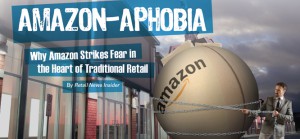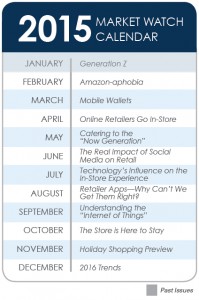 By Retail News Insider
By Retail News Insider
Amazon—it’s a name that strikes fear in the hearts of most brick-and-mortar retailers. With 237 million active customer accounts worldwide, over $74 billion in annual revenue and an average growth rate of 22 percent, the e-tailer is a force in both the online and traditional marketplaces. From its humble beginnings as an online bookstore based out of founder Jeff Bezos’ garage, Amazon has risen to become the largest online retailer in North America, selling everything from books, music and movies to cosmetics, diapers and groceries. Over the past two decades, Amazon has slowly chipped away at nearly every advantage brick-and-mortars once staked a claim to—and it shows no signs of slowing down.
 Reality Check
Reality CheckIf you’re not online, you don’t exist. A robust online presence combined with the benefits of multiple brick-and-mortar locations can give traditional retailers a leg up.
The online leader is continually innovating new services and benefits to steal brick-and-mortar shoppers away, patenting one-click shopping in 1999, expanding into the health and personal care markets in 2003, adding Amazon Fresh grocery services in 2006 and instant video in 2011. Its latest introductions, including the Amazon Echo™ speaker/personal assistant and expanding line of Fire™ tablets, phones and media players, are designed to make the bond between consumers and Amazon tighter than ever before. Could they be the final deathblow to brick-and-mortar retailers and the CPGs who serve them? Retail News Insider set out to investigate.
First, a look at the latest tools sending shivers down traditional retailers’ backs: Fire and Echo. Fire tablets and phones are equipped with Amazon’s proprietary software that allows users to quickly and easily compare prices on items across different stores and order items through the retailer simply by pressing a button or even taking a photo of a product. And Fire media players allow users to access and browse Amazon’s streaming TV, movie and game offerings just by saying a command.
Amazon’s most recent innovation, Echo, is an interactive speaker that acts as both a device to stream music through and a personal assistant. Its “brain” is connected to the cloud, allowing users to ask it questions like “What’s the weather going to be like today,” add items to their shopping list, and yes—even order directly through Amazon—all without having to type a single word.
Check out Echo in action:
]
Echo is always on and listening for its name (“Alexa,” to be precise), no matter where a consumer is in his or her home. The more the consumer talks to her, the more Alexa learns his or her preferences. Though it’s not promoted as such, Echo essentially moves an Amazon sales rep right into shoppers’ homes, ready to take their orders 24 hours a day, 7 days a week.
To be sure, Amazon is trying to becoming consumers’ one-stop shopping solution. But despite retailers’ and CPGs’ fears, all is not lost. “There is room for both Amazon and traditional retailers,” says Jeff Engel, Senior Vice President of Retail for Interactions. “Amazon gives consumers a limited experience. They go online, they pick out an item and it gets delivered to their door. Brick-and-mortar retailers can offer so much more through the in-store experience and one-on-one human interaction.”
There’s plenty of evidence in the marketplace to support Engel’s assertion. Numerous traditional retailers are still seeing gains in sales and foot traffic despite Amazon’s encroachment. The way they’re doing it, by and large, is by giving consumers something they can’t get from the online retailer—whether it’s a product, a level of service or an experience.
 Reality Check
Reality CheckThink differentiation, not direct competition. For example, traditional grocers can use their strengths in the fresh and local markets to win shoppers over.
For example, in December 2014, Macy’s introduced same-day delivery service in seven cities across the country, allowing shoppers to order any of the items the retailer offers online and have them delivered from a local Macy’s store to their home later that day. While Amazon also offers same-day service, it is limited to the few areas where Amazon warehouses already exist. Macy’s program has much better potential for widespread growth, with the retailer already having a brick-and-mortar presence—and therefore an established distribution channel—in over 700 stores across the country.
For the grocery market, capitalizing on produce, meats and dairy products is key. While Amazon does offer these items through its Fresh program, it’s limited to the Seattle, San Francisco, San Diego and New York areas. And it requires shoppers to outlay an initial $299 just for a membership fee. There’s huge opportunity, then, for traditional grocery retailers to capture shoppers’ loyalty by providing and promoting fresh, high-quality perishables in a convenient location at a fair price.
Promotion and differentiation as a fresh provider must also be tied in with an effective strategy for engagement. To this point, Engel notes, “You have to engage with consumers on multiple levels. You have to define your target audience and determine the unique ways they’re going to connect best. Then you can build a strategy around that, constantly assessing and adjusting your plan based on the insights you gain from analytics.”
Another way traditional retailers can successfully reel in would-be Amazon shoppers is by creating their own robust online presence as a complement to their brick-and-mortar stores. Retailers can play on consumers’ desire for convenience by offering multiple options for pickup and/or delivery, as well as returns. A leader in this arena is Wal-Mart, which smashed its record for online sales this past Cyber Monday—a shopping day traditionally thought to favor e-tailers like Amazon. But unlike Amazon, Wal-Mart gives consumers the option to come into the store to try out products first, then decide whether to buy them here or order them online. Online shoppers also get to choose whether to have items shipped to their homes or a local brick-and-mortar store. In addition, Wal-Mart will match advertised online prices from other retailers, including Amazon—giving shoppers the convenience of getting what they want, at the price they want and when they want it.
If you can’t beat ‘em, consider joining ‘em. CPGs can benefit from joining forces with Amazon and capitalizing on its technological savvy.
For traditional CPGs, succeeding in an Amazon world may not be so much about trying to compete with them. Rather, there may be benefits to joining forces. Though some CPGs bemoan the slim profit margins Amazon offers, there are potential upsides to be gained through access to its platform. One of the biggest potential benefits, especially for newer and smaller brands, is the opportunity for immense lift in exposure. Even for shoppers who don’t end up buying online, e-tailers like Amazon are often where they start their research.
 Creating a collaborative relationship with Amazon can also give CPGs greater control over how their products are sold through the retailer. Currently, unless a CPG has a specific agreement with Amazon, any third-party seller can make their products available through the online retailer. But several brands that have agreed to work directly with Amazon, such as Levi Strauss and Burberry, have gained the exclusive right to sell their wares directly, blocking third-party resellers and protecting their bottom lines.
Creating a collaborative relationship with Amazon can also give CPGs greater control over how their products are sold through the retailer. Currently, unless a CPG has a specific agreement with Amazon, any third-party seller can make their products available through the online retailer. But several brands that have agreed to work directly with Amazon, such as Levi Strauss and Burberry, have gained the exclusive right to sell their wares directly, blocking third-party resellers and protecting their bottom lines.
All in all, there’s no doubt that Amazon is a force to be reckoned with. But its innovation doesn’t have to be at the detriment of traditional retail. Just as Amazon has brought disruption to the traditional retail model, so too must traditional retailers and CPGs find ways to disrupt the status quo in order to pave the road to future success.

